-
01/01/2018
Declínio da mortalidade por câncer cervical
Revista Brasileira de Enfermagem. 2018;71:585-590
Resumen
Declínio da mortalidade por câncer cervical
Revista Brasileira de Enfermagem. 2018;71:585-590
DOI 10.1590/0034-7167-2016-0530
Visualizações0Ver maisRESUMEN
Objetivo:
Describir la ocurrencia de mortalidad por cáncer cervical en Recife (PE), en el noreste de Brasil.
Método:
Este fue un estudio ecológico de series temporales que utilizó datos del Sistema de Información de Mortalidad (SIM) sobre el número total de muertes por cáncer cervical (C53 ICD10) ocurridas entre 2000 y 2012.
Resultados:
Se observó que el riesgo de muerte por esta forma de cáncer fue mayor entre las mujeres mayores de 60 años, las de color de piel mixto (53.24%), las que sólo trabajaban en casa (63.16%) y las que no tenían pareja (44.32%).
Conclusión:
Se requieren esfuerzos adicionales para mantener los programas de detección precoz y educación sanitaria y para utilizar estrategias terapéuticas de mayor eficacia, ya que la mortalidad por esta forma de cáncer se considera evitable cuando se diagnostica tempranamente.
-
PESQUISA01/01/2018
Adhesion to patient safety protocols in emergency care units
Revista Brasileira de Enfermagem. 2018;71:577-584
Resumen
PESQUISAAdhesion to patient safety protocols in emergency care units
Revista Brasileira de Enfermagem. 2018;71:577-584
DOI 10.1590/0034-7167-2017-0504
Visualizações0Ver maisABSTRACT
Objective:
To investigate compliance of national patient safety protocols in Emergency Care Units (UPA) of the Paraná State.
Method:
From April until September 2016, the exploratory stage of the action research was conducted on stratified sampling with 377 patients of eight units, with use of verification instrument of basic safety actions.
Results:
The absence of systematic identification of patients, fall risk assessment and signaling and development of pressure injuries were evidenced. We observed that 52.8% of parenteral solutions in use were not identified and that, in only 29.4% of the cases, the allergic condition was investigated. In 80.6% of the emergency units there was availability of alcoholic solution to hand hygiene.
Conclusion:
We concluded that the non-compliance of basic actions concerning patient safety exposes users to preventable adverse events and demands systematized actions to comply with government guidelines and promote quality of health assistance.
-
PESQUISA01/01/2018
Epidemiological overview of HIV/AIDS in pregnant women from a state of northeastern Brazil
Revista Brasileira de Enfermagem. 2018;71:568-576
Resumen
PESQUISAEpidemiological overview of HIV/AIDS in pregnant women from a state of northeastern Brazil
Revista Brasileira de Enfermagem. 2018;71:568-576
DOI 10.1590/0034-7167-2017-0495
Visualizações0Ver maisABSTRACT
Objective:
To learn the epidemiological characteristics of HIV infection in pregnant women.
Method:
Descriptive study with quantitative approach. The study population was composed of pregnant women with HIV/AIDS residing in the state of Alagoas. Data were organized into variables and analyzed according to the measures of dispersion parameter relevant to the arithmetic mean and standard deviation (X ± S).
Results:
Between 2007 and 2015, 773 cases of HIV/AIDS were recorded in pregnant women in Alagoas. The studied variables identified that most of these pregnant women were young, had low levels of education and faced socioeconomic vulnerability.
Conclusion:
It is necessary to include actions aimed at increasing the attention paid to women, once the assurance of full care and early diagnosis of HIV are important strategies to promote adequate treatment adherence and reduce the vertical transmission.
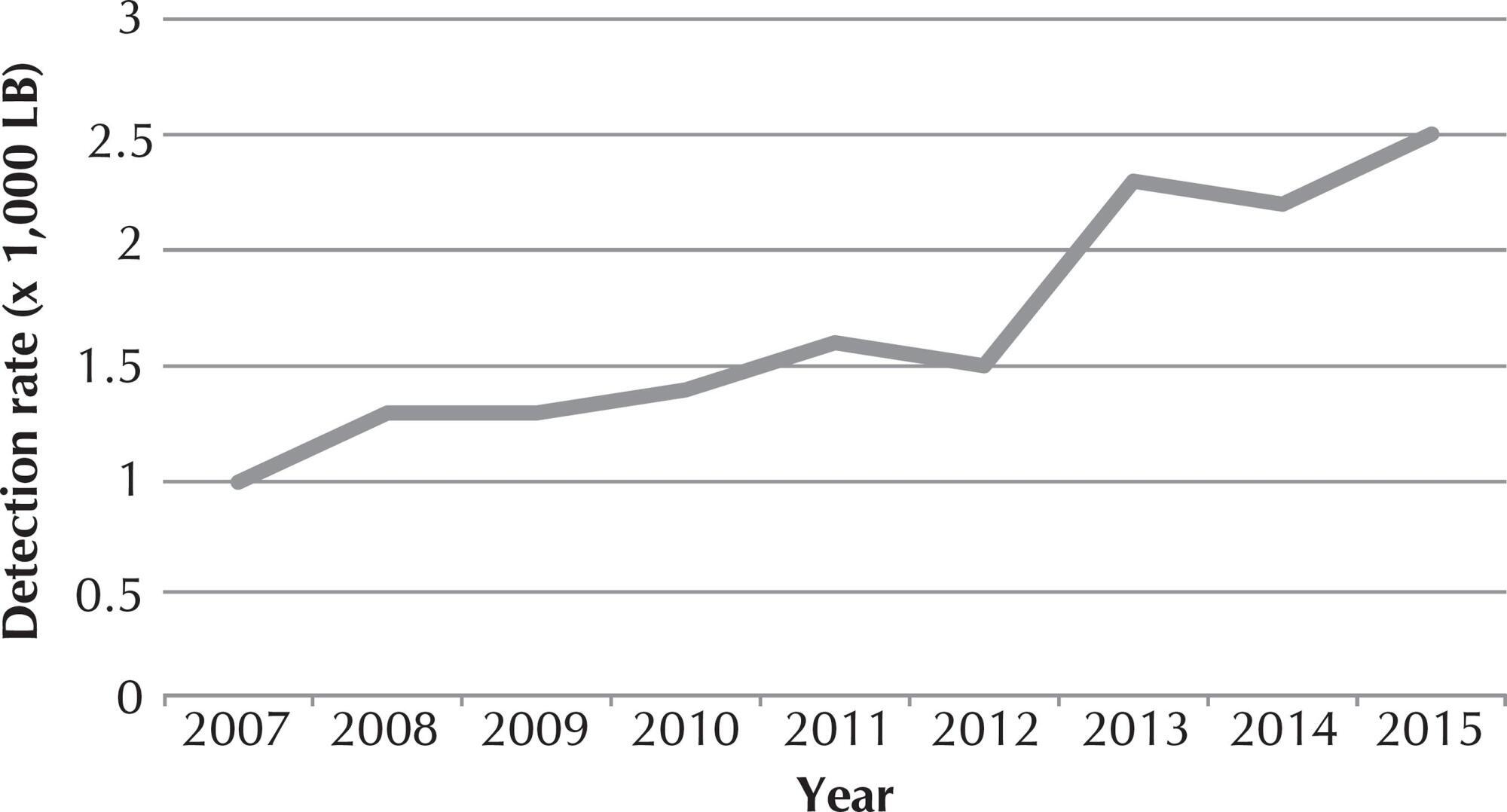
-
PESQUISA01/01/2018
Hand hygiene management among nurses: collective health challenges
Revista Brasileira de Enfermagem. 2018;71:562-567
Resumen
PESQUISAHand hygiene management among nurses: collective health challenges
Revista Brasileira de Enfermagem. 2018;71:562-567
DOI 10.1590/0034-7167-2017-0538
Visualizações0Ver maisABSTRACT
Objective:
To describe the determining factors in hand hygiene management among nurses and identify associated collective health challenges.
Method:
Cross-sectional descriptive study. Data were collected using a questionnaire that was applied in four internal medicine units of a hospital of reference in Portugal.
Results:
The sample was composed of 50 nurses aged 26 to 55 years (mean age of 34.88 years); 80% were women, 58% had a Bachelor’s degree, and had 5-30 years of nursing practice (X̄ =11.94;±5.92). The vast majority of nurses (90%) reported complying with the existing recommendations on hand hygiene in pre-established moments. However, none of the nurses were able to identify all the moments for hand hygiene using water and soap or alcohol-based handrub.
Conclusion:
This study shows that continuous training, adequate materials/structures in the units, and redesigned administration/supervision practices are determining factors to achieve higher levels of adherence to hand hygiene among nurses, as well as increased quality and safety in care delivery, which is a current collective health challenge.
-
PESQUISA01/01/2018
How do old men take care of their own health in Primary Care?
Revista Brasileira de Enfermagem. 2018;71:554-561
Resumen
PESQUISAHow do old men take care of their own health in Primary Care?
Revista Brasileira de Enfermagem. 2018;71:554-561
DOI 10.1590/0034-7167-2017-0131
Visualizações0Ver maisABSTRACT
Objective:
To understand the care of elderly men with their own health.
Method:
A qualitative study with the participation of ten elderly men, through responses to the semi-structured interview guided by the “Tell me about your experiences of care with your health”, carried out in a basic health unit, during the period of October-December 2014. The speeches, after being transcribed were submitted to content analysis.
Results:
The ten interviewees were retired and had an average age of 67.3 years. From the analysis of the data, two categories have emerged: Elderly health care ways and health service as a supporter in the care (less) of the elderly, which revealed the restriction of health care to the triad: medicines, consultation to professionals and exams.
Final considerations:
Institutional and sociocultural barriers that need to be overcome so that the male population can be consolidated, guaranteeing care of their peculiarities, encouraging active behaviors for self-care.
-
PESQUISA01/01/2018
Nurse liaison: a strategy for counter-referral
Revista Brasileira de Enfermagem. 2018;71:546-553
Resumen
PESQUISANurse liaison: a strategy for counter-referral
Revista Brasileira de Enfermagem. 2018;71:546-553
DOI 10.1590/0034-7167-2017-0490
Visualizações0Ver maisABSTRACT
Objective:
to identify the profile of the counter-referred patients by the “nurse liaison” and to describe the experience of the professionals who participated in the project.
Method:
intervention research, with twelve nursing nurses from a hospital and an Emergency Care Unit, and 26 nurses from Primary Health Care. Data were obtained through questionnaires and counter-referral forms.
Results:
Out of 43 counter-referred individuals, 62.8% are over sixty years, 53.5% are men with multi-pathologies. Among the positive aspects, the nurses highlighted the dialogue between health care services, agility in the acquisition of inputs for the continuity of care in primary care, benefiting patients after hospital discharge. The greatest challenge was the lack of time and the deficit of nurses to perform the function.
Final considerations:
the presence of the “nurse liaison” has proved to be an important strategy to improve integration between services and to promote continuity of care.
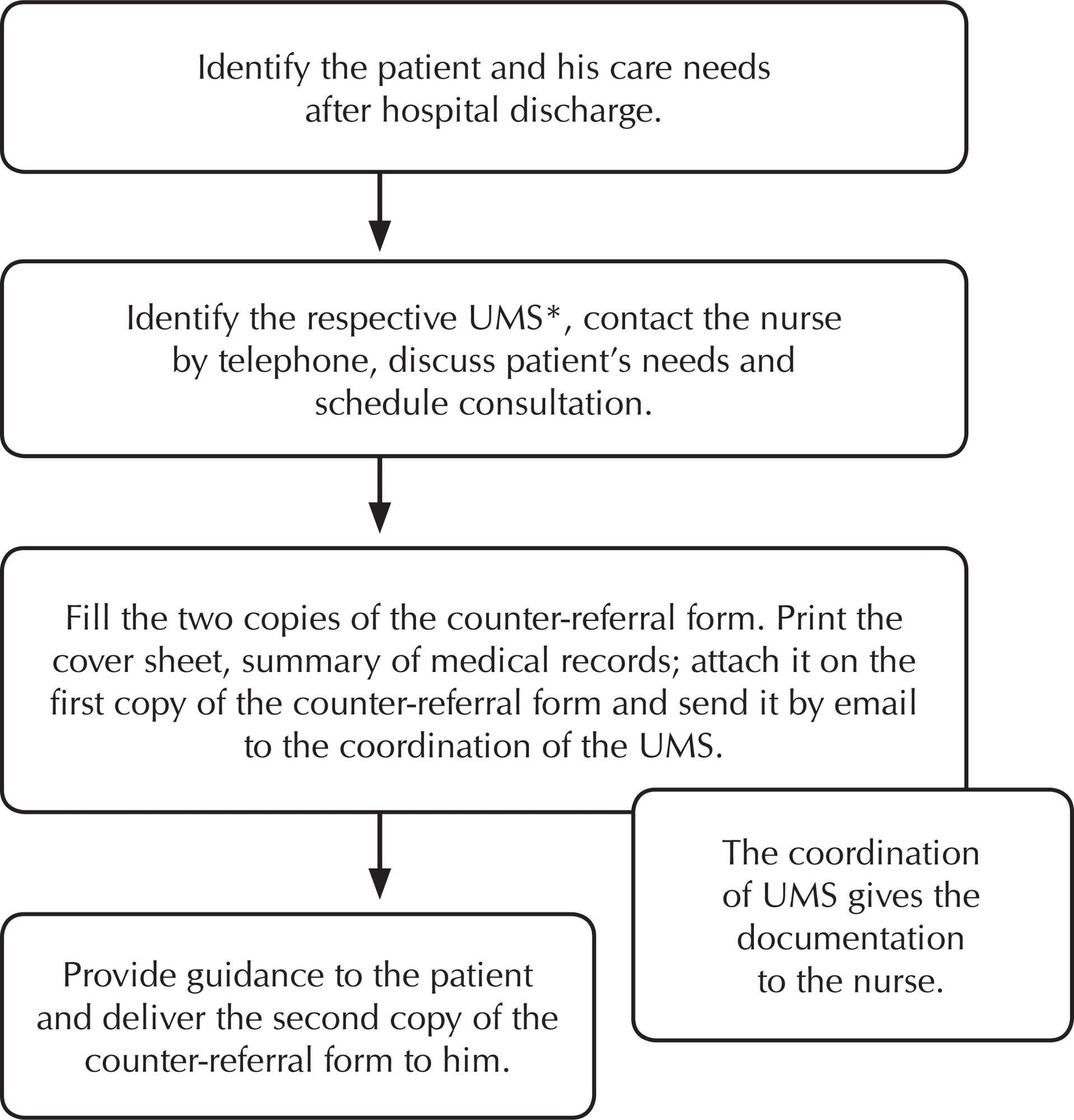
-
PESQUISA01/01/2018
Depression in the wives of convicted men: prevalence and associated factors
Revista Brasileira de Enfermagem. 2018;71:538-545
Resumen
PESQUISADepression in the wives of convicted men: prevalence and associated factors
Revista Brasileira de Enfermagem. 2018;71:538-545
DOI 10.1590/0034-7167-2017-0263
Visualizações0Ver maisABSTRACT
Objective:
To estimate the prevalence of depression and to identify the main risk factors associated with depression in wives of convicted men.
Method:
Descriptive, cross – sectional, quantitative approach. The data were collected with 349 female partners of convicted patients in three penitentiaries in the state of Paraná, with a semistructured research, between January and June of 2016, being compiled in a database and analyzed using SPSS® 20.0 software.
Results:
It was possible to identify vulnerability to depression among wives of convicted men, most were young and 42.2% have or already had depression. It was verified that the variables to depression were ages equal to or above 30 years (50.3%, p <0.001), smoking (61.1%, p <0.013) and alcoholism (16.1%, p <0.001).
Conclusion:
It is the responsibility of the nurse with the multidisciplinary health team to invest in health promotion and prevention actions against these risk factors that were associated with depression in this population.
-
01/01/2018
Primary health care: the experience of nurses
Revista Brasileira de Enfermagem. 2018;71:531-537
Resumen
Primary health care: the experience of nurses
Revista Brasileira de Enfermagem. 2018;71:531-537
DOI 10.1590/0034-7167-2016-0244
Visualizações0ABSTRACT
Objective:
to understand the meaning of nursing care in primary health care from the perspective of Chilean nurses.
Method:
this was a qualitative study based on the social phenomenology of Alfred Schutz. Data was collected between January and April 2013, through interviews with 13 primary health care nurses in Chile.
Results:
the nurses perceived primary care as a gratifying experience, considering it an encounter of subjectivities. However, they felt burdened with multiple functions and by the hierarchical pressure to achieve targets. They strived to implement innovative care, expressed by the desire to go beyond traditional care practices, and improve the efficiency of management at the various levels of health care.
Conclusion:
it is important to discuss the results of the present study in the context of health care and especially nursing education, with the goal of better preparing nurses who will deliver care at the primary health care level.
Palavras-chave: Family Nurse PractitionersNursing CarePractical NursingPrimary Health CareQualitative ResearchVer mais
-
ARTÍCULO ORIGINAL21/10/2019
Occupational stress and engagement in primary health care workers
Revista Brasileira de Enfermagem. 2019;72(6):1580-1587
Resumen
ARTÍCULO ORIGINALOccupational stress and engagement in primary health care workers
Revista Brasileira de Enfermagem. 2019;72(6):1580-1587
DOI 10.1590/0034-7167-2018-0681
Visualizações0Ver maisABSTRACT
Objective:
To evaluate levels of occupational stress and work engagement among primary health care workers.
Method:
A descriptive, correlational and transversal study was carried out in a small municipality in the countryside of São Paulo, with a non-probabilistic sample of convenience, with 85 workers. Three self-applied instruments were used: one developed by researchers, containing sociodemographic variables; Work Stress Scale (WSS) and Utrech Work Engagement Scale (UWES).
Results:
Prevalence of women (72.6%), 40 years old or more (45.9%), 4 years and 4 months of mean working time in primary care. Thirty-one workers (36.5%) presented significant stress (scores ≥2.5). Work engagement showed a mean of 4.1 (±1.2) to 4.4 (±1.4), classified as high in all dimensions. Occupational stress and work engagement correlated negatively.
Conclusion:
Workers presented high levels of work engagement; more than one-third had significant occupational stress. Workers with high levels of occupational stress tend to have lower work engagement.
-
ARTÍCULO ORIGINAL01/07/2020
Patient safety culture: perception of nursing professionals in high complexity institutions
Revista Brasileira de Enfermagem. 2020;73(5):e20190174
Resumen
ARTÍCULO ORIGINALPatient safety culture: perception of nursing professionals in high complexity institutions
Revista Brasileira de Enfermagem. 2020;73(5):e20190174
DOI 10.1590/0034-7167-2019-0174
Visualizações1Ver maisABSTRACT
Objectives:
to analyze the perception of nursing professionals about patient safety culture in three highly complex hospital institutions.
Methods:
descriptive and quantitative study with professionals working in care. The Hospital Survey on Patient Safety Culture questionnaire was applied, classifying its dimensions according to the percentage of positive responses (strengthened: ≥75.0%; potential for improvement: <75.0% to> 50.0%; weakened: ≤50.0%).
Results:
four hundred sixty-seven professionals (79.6%), mostly women (88.4%), nursing technicians/assistants (57.2%), 20 to 39 years (60.8%), less than five years in the institution (57.8%) and exclusive bond (79.2%) participated in the study. Safety culture was considered fragile, seven dimensions assessed as such, highlighting “Openness to communication” and “Non-punitive responses to errors” with <30.0% positive responses.
Conclusions:
evidence of the need for discussion of the subject and strategies for change that promote quality and safety of care.
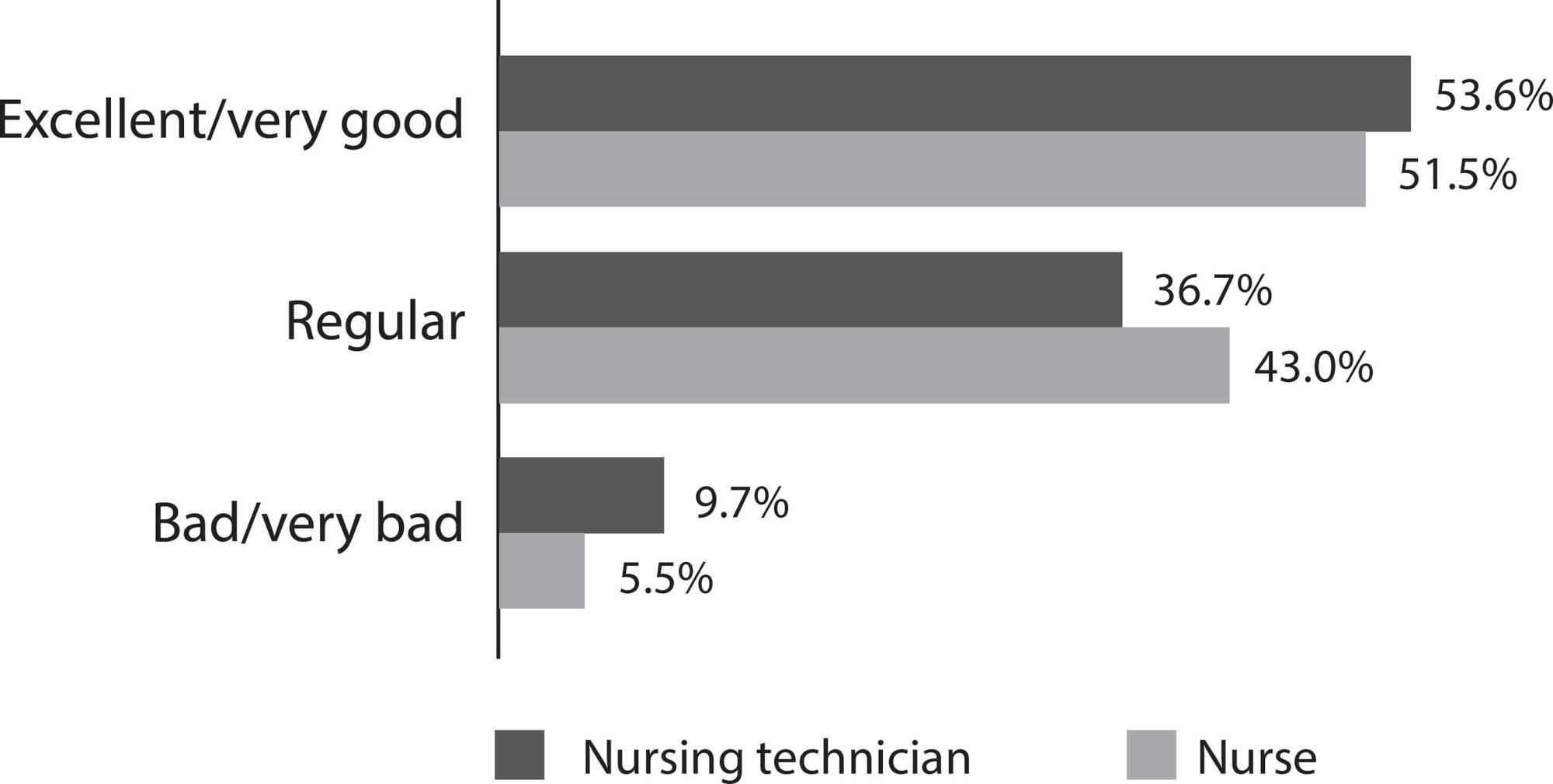
-
ARTÍCULO DE REVISIÓN06/11/2020
Cuidado transicional aos cuidadores de idosos dependentes: revisão integrativa da literatura
Revista Brasileira de Enfermagem. 2020;73:e20200394
Resumen
ARTÍCULO DE REVISIÓNCuidado transicional aos cuidadores de idosos dependentes: revisão integrativa da literatura
Revista Brasileira de Enfermagem. 2020;73:e20200394
DOI 10.1590/0034-7167-2020-0394
Visualizações0Ver maisRESUMO
Objetivo:
Identificar as necessidades dos cuidadores de idosos dependentes para o autocuidado na transição do hospital para casa.
Métodos:
Revisão integrativa que seguiu um protocolo pré-definido, realizada de março a maio de 2019, nas plataformas EBSCO, B-On, Scopus, Web of Science e Joanna Briggs Institute. Foram definidos descritores e critérios de elegibilidade para a amostra bibliográfica, que ficou constituída por dez artigos. Pela atualidade da evidência, limitou-se a pesquisa aos anos de 2015 a 2019.
Resultados:
As necessidades de cuidados transicionais para os cuidadores agrupam-se em cinco categorias: necessidades na transição para o papel de cuidador, necessidades de autocuidado dele próprio, necessidades de saúde, necessidades econômicas e necessidades sociais e comunitárias.
Considerações finais:
O cuidado transicional para os cuidadores deve ter dois focos de atenção, por parte dos enfermeiros: a gestão dos cuidados ao familiar dependente e a gestão das necessidades e dos cuidados ao próprio cuidador.
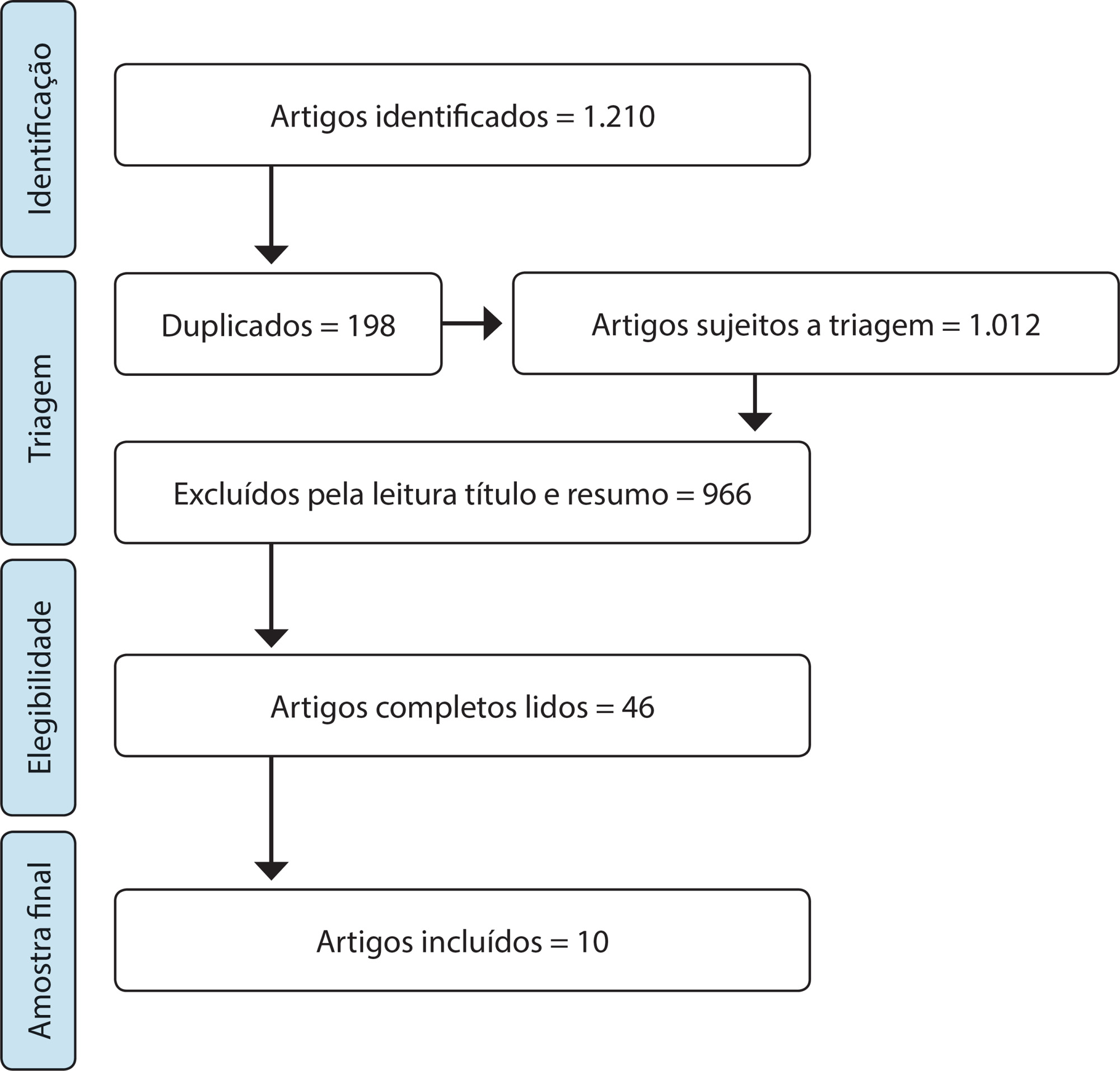
-
ARTÍCULO ORIGINAL24/05/2021
PEDCARE: validação de um aplicativo móvel sobre o autocuidado com o pé diabético
Revista Brasileira de Enfermagem. 2021;74:e20200856
Resumen
ARTÍCULO ORIGINALPEDCARE: validação de um aplicativo móvel sobre o autocuidado com o pé diabético
Revista Brasileira de Enfermagem. 2021;74:e20200856
DOI 10.1590/0034-7167-2020-0856
Visualizações0RESUMO
Objetivo:
descrever o processo de validação de aplicativo multimídia em plataforma móvel para a promoção de cuidado com os pés de pessoas com diabetes.
Método:
estudo de produção tecnológica, do tipo metodológico. O conteúdo e a aparência foram validados por 39 juízes (29 juízes na área de enfermagem e dez com experiência profissional em tecnologia da informação e comunicação e 15 pessoas do público-alvo).
Resultados:
os juízes na área de enfermagem possibilitaram a validação do material com Índice de Validade do Conteúdo total de 0,95, teste binomial não significativo para maioria dos itens e alfa de Cronbach de 0,92, juízes da área de tecnologia da informação e comunicação com Suitability Assessment of Materials de 99,2% e o público-alvo com Índice de Concordância de 98%.
Conclusão:
o aplicativo mostrou-se válido e confiável para uso na prática clínica como tecnologia educacional para promoção de cuidados com os pés de pessoas com diabetes.
Palavras-chave: Aplicativos MóveisDiabetes MellitusEducação em SaúdeEstudos de ValidaçãoPé DiabéticoVer mais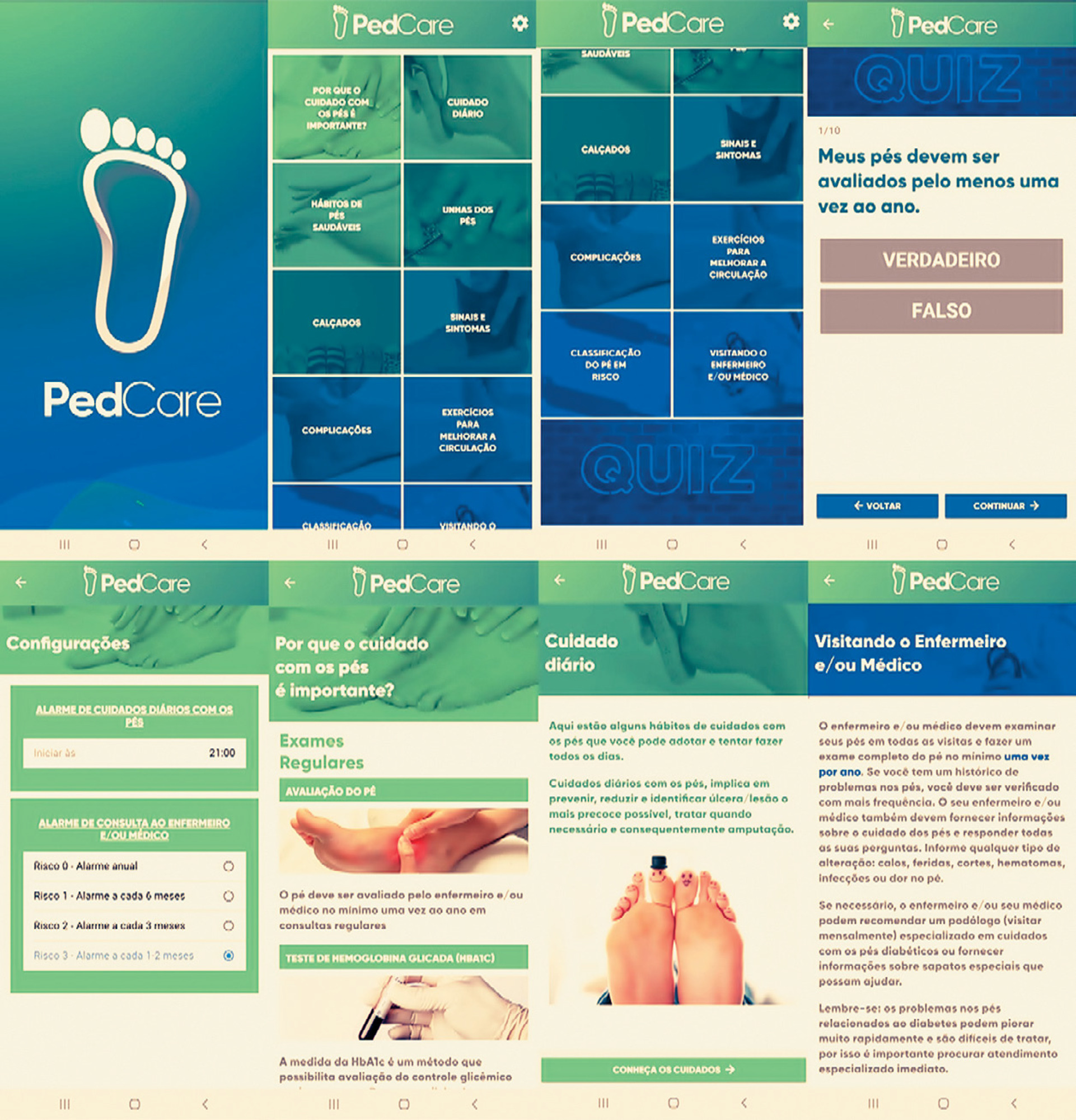
-
INFORME DE EXPERIENCIA09/04/2020
Implantação de algoritmo de inteligência artificial para detecção da sepse
Revista Brasileira de Enfermagem. 2020;73(3):e20180421
Resumen
INFORME DE EXPERIENCIAImplantação de algoritmo de inteligência artificial para detecção da sepse
Revista Brasileira de Enfermagem. 2020;73(3):e20180421
DOI 10.1590/0034-7167-2018-0421
Visualizações0RESUMO
Objetivos:
apresentar a experiência de enfermeiros com inovações tecnológicas computacionais no apoio à identificação precoce da sepse.
Métodos:
relato de experiência de pré e pós-implantação de algoritmos baseados em inteligência artificial para a prática clínica em um hospital filantrópico, no primeiro semestre de 2018.
Resultados:
descrevem a motivação, para criação e uso do algoritmo, o papel do enfermeiro no desenvolvimento e na implantação dessa tecnologia e os seus efeitos no processo de trabalho da enfermagem.
Considerações Finais:
inovações tecnológicas precisam contribuir para a melhoria das práticas profissionais em saúde. Assim, enfermeiros devem reconhecer seu papel em todas as etapas desse processo, de modo a garantir o cuidado seguro, efetivo, centrado no paciente. No caso apresentado, a participação dos enfermeiros no processo de incorporação tecnológica potencializa a rápida tomada de decisão na identificação precoce da sepse.
Palavras-chave: Fidelidade a DiretrizesInformática em EnfermagemInteligência Artificial SepseTomada de DecisõesVer mais -
ARTÍCULO DE REVISIÓN24/03/2021
Development of clinical competence in nursing in simulation: the perspective of Bloom’s taxonomy
Revista Brasileira de Enfermagem. 2021;74(1):e20200135
Resumen
ARTÍCULO DE REVISIÓNDevelopment of clinical competence in nursing in simulation: the perspective of Bloom’s taxonomy
Revista Brasileira de Enfermagem. 2021;74(1):e20200135
DOI 10.1590/0034-7167-2020-0135
Visualizações0Ver maisABSTRACT
Objectives:
to investigate the scientific evidence on the use of Bloom’s taxonomy for developing competence in nursing professionals and students in clinical simulation.
Methods:
integrative review of the National Library of Medicine (NLM), National Institutes of Health (NIH), Cumulative Index to Nursing and Allied Health Literature (CINAHL), Latin American and Caribbean Literature in Health Sciences (LILACS), Web of Science and SCOPUS databases, using the Rayyan application.
Results:
a total of 871 studies were identified; four composed the sample. The development of clinical competence occurred through the coordination of knowledge, skills, and attitudes. To develop the cognitive domain, the objectives of knowledge and comprehension of the Bloom’s taxonomy were mobilized. The psychomotor domain required development of the skills demanded by the proposed clinical care. The affective domain was developed through will and motivation to learn.
Conclusions:
it is possible to develop clinical competence in nursing by adopting Bloom’s taxonomy in each phase of clinical simulation.
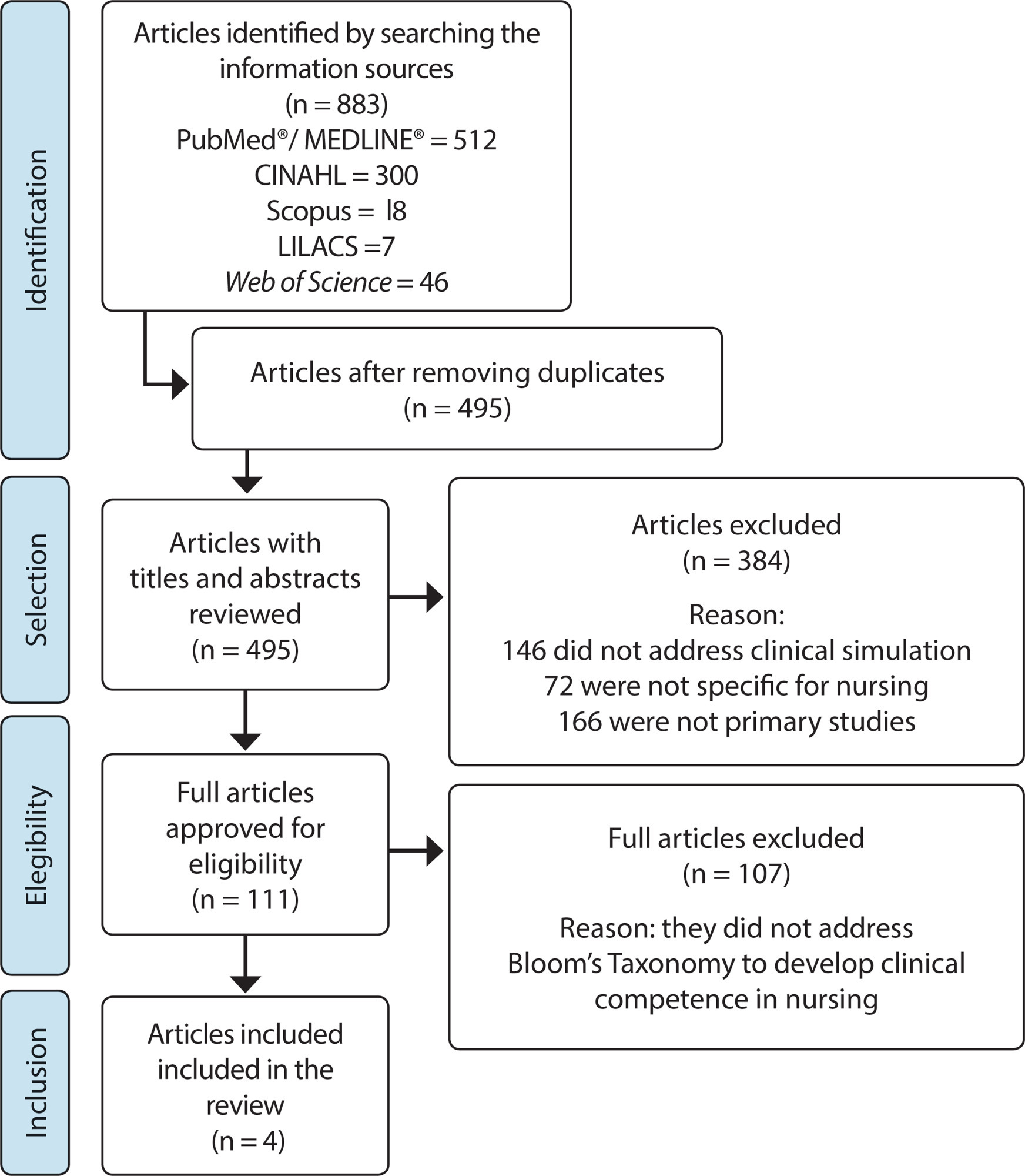
-
27/03/2020
Coronavirus 2020
Revista Brasileira de Enfermagem. 2020;73(2):e2020n2
Resumen
Coronavirus 2020
Revista Brasileira de Enfermagem. 2020;73(2):e2020n2
DOI 10.1590/0034-7167-2020730201
Visualizações0Las enfermedades infecciosas emergentes y reemergentes son desafíos constantes para la salud pública en todo el mundo. Los casos recientes de neumonía de causa desconocida en Wuhan, China, han llevado al descubrimiento de un nuevo tipo de Coronavirus (2019-nCoV), que son virus de RNA envueltos, comúnmente encontrados en humanos, otros mamíferos y aves, capaces de […]Ver mais -
ARTÍCULO ORIGINAL04/12/2020
Lesão por pressão relacionada ao uso de equipamentos de proteção individual na pandemia da COVID-19
Revista Brasileira de Enfermagem. 2020;73:e20200670
Resumen
ARTÍCULO ORIGINALLesão por pressão relacionada ao uso de equipamentos de proteção individual na pandemia da COVID-19
Revista Brasileira de Enfermagem. 2020;73:e20200670
DOI 10.1590/0034-7167-2020-0670
Visualizações0RESUMO
Objetivo:
Descrever prevalência e fatores associados da lesão por pressão relacionada ao uso de equipamentos de proteção individual durante a pandemia da COVID-19.
Métodos:
Estudo transversal realizado por meio de instrumento disponibilizado em redes sociais com 1.106 profissionais de saúde. Os dados foram analisados por meio de estatística descritiva e comparada, considerando valor de p < 0,05.
Resultados:
Houve prevalência de 69,4% para lesão por pressão relacionada ao uso do equipamento de proteção individual, com uma média de 2,4 lesões por profissional. Os fatores significativos foram: menores de 35 anos de idade, trabalhar e fazer uso de equipamentos de proteção individual por mais de seis horas no dia, em unidades hospitalares e sem o uso de insumos para proteção.
Conclusão:
A lesão por pressão relacionada ao uso de dispositivos médicos apresentou alta prevalência nessa população. O reconhecimento da lesão nesses profissionais possibilita avançar em estratégias de prevenção.
Palavras-chave: CoronavírusEquipamento de Proteção IndividualLesão por PressãoPandemiasPessoal de SaúdeVer mais
Búsqueda
Buscar en:
Nuvem de Tags
Adolescente (85) Atenção Primária à Saúde (239) COVID-19 (91) Criança (91) Cuidados de Enfermagem (269) Educação em Enfermagem (151) Educação em Saúde (139) Enfermagem (930) Enfermagem Pediátrica (86) Estudantes de Enfermagem (77) Estudos de Validação (131) Família (87) Idoso (208) Promoção da Saúde (99) Qualidade de Vida (104) Saúde do Trabalhador (86) Saúde Mental (145) Saúde Pública (82) Segurança do Paciente (150) Tecnologia Educacional (100)



